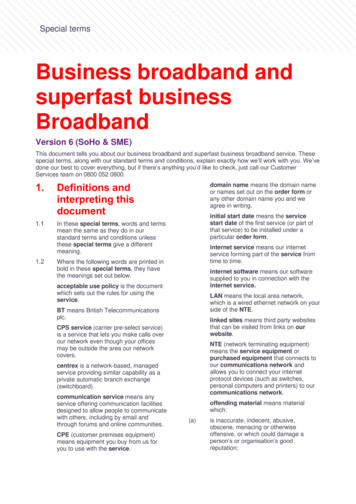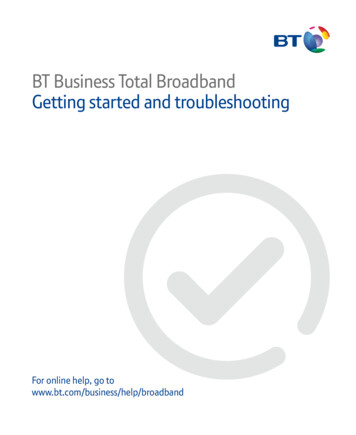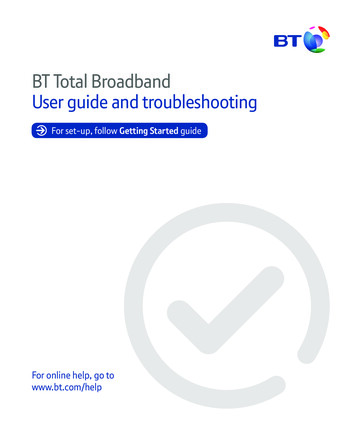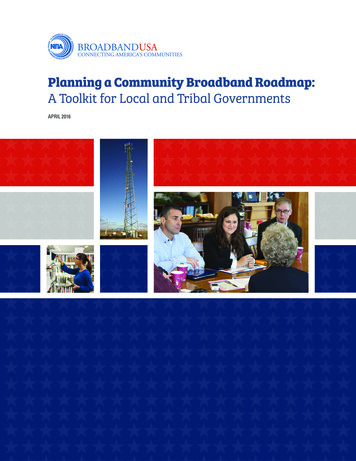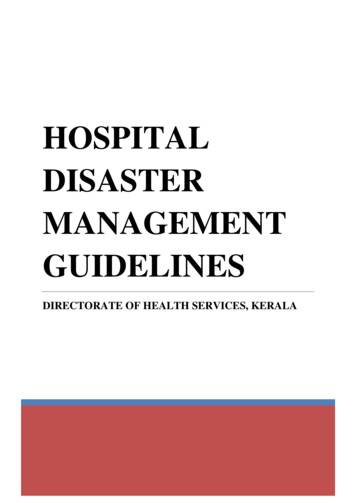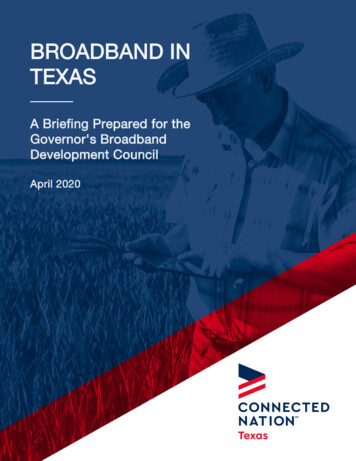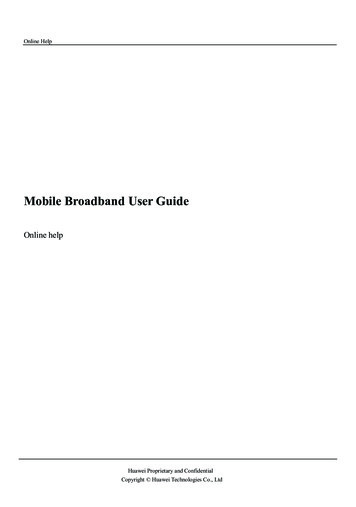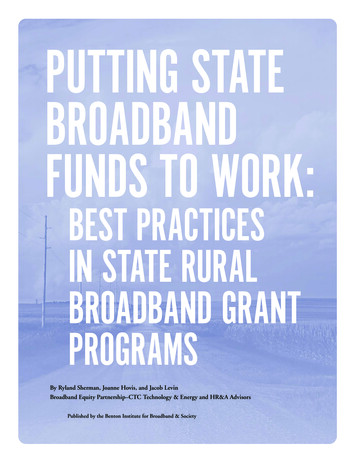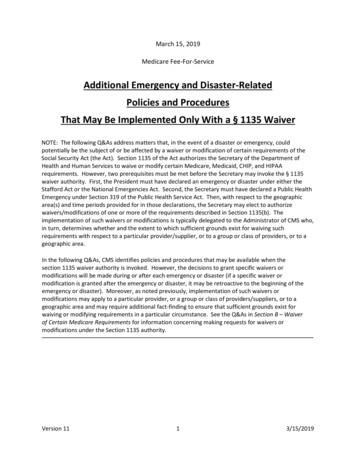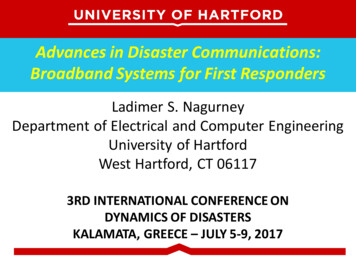
Transcription
Advances in Disaster Communications:Broadband Systems for First RespondersLadimer S. NagurneyDepartment of Electrical and Computer EngineeringUniversity of HartfordWest Hartford, CT 061173RD INTERNATIONAL CONFERENCE ONDYNAMICS OF DISASTERSKALAMATA, GREECE – JULY 5-9, 2017
Communications RequirementsFirst 24 Hours24 – 48 Hours3-30 DaysRescueCommand/ControlDisaster rian Calling and NewsBandwidth Increases
Communications RequirementsFirst 24 Hours24 – 48 Hours3-30 DaysBandwidthTime
Trends Transforming Disaster Communications1. An increased level of community engagement2. Real-time data is accessed in the field3. Increased communications with neighboringagencies4. Collaborative technologies are used to expandcapabilities5. Managing the technology skills.
Types of Disaster Related Communications1. Mission Critical Communication2. Non-Mission Critical Communication3. Broadband for First Responders – FirstNet inthe US
Current State
Mission Critical Communications (MCC)1. Messages (voice/data) must be transmittedimmediately (low latency)2. For situational awareness, usually requiresthat all involved receive the message(s)3. Key metric is reliability – for MCC, most firstresponders just want what works!
A Brief Background on Communications LMR – Land Mobile Radio – Conventional 2way radio that is ubiquitous in public safetyagencies.
LMR – Simplex vs Repeater
LMR – TrunkedRecognizes that the Radio Spectrum is a scarceresource and that messages are not continuous.Channel 1Channel 2Channel 3A BCDDACB
Conventional - TETRA - P25 - DMR Conventional – Traditional analogcommunications systems that have existedsince the 1930s. TETRA - Terrestrial Trunked Radio - Europeanstandard (1995) designed for public safetynetworks. Also used for transportationnetworks and the military.
Conventional - TETRA - P25 - DMR P25 - Project 25 or APCO-25 – NorthAmerican standards for digital radiocommunications for use by public safetyorganizations to enable interoperation. DMR - Digital Mobile Radio - An open digitalmobile radio standard defined by ETSI in2005 and used internationally.
Interoperability
InteroperabilityAnswer – Broadband!
LTE – Long Term Evolution LTE - Long Term Evolution - the standard used bymost of our smart phones and devices. The driving factor for adopting LTE for theEmergency Communications sector is theincreased need for broadband data applications. Requires cell sites and infrastructure. Well established in the consumer market, butrequires enhancements to address the needs ofPublic Safety/Critical Communications.
Features needed for LTE for MCC Proximity Services to allow mobiles to identifyother mobiles in physical proximity and enablesDirect Device-to-Device calls allowingcommunication even when the network is downor where no network exists. User equipment to network relay allows onemobile to act as a relay for another and providesaccess to network services outside the normalnetwork coverage area.
Features needed for LTE for MCC User equipment relay allows mobiles to act asrelay points between other mobiles, permittingcommunication without going via the networkeven if the mobiles are out of direct range. Mission Critical Push-To-Talk (MCPTT) allowsradio-like communication over LTE. Security features to protect the system fromunauthorized users, eavesdropping, denial ofservice attacks, and other security risks.
Differences between LTE and LMR
LMR vs LTE
4 Basic LTE Network Components
ProblemWhen a disaster occurs, Broadband use (SmartPhone – Tablet) increases to the point that thenetwork becomes congested and throughputessentially goes to zero.First responders who have immediate need forbroadband cannot access the network.
What is needed for Public Safety Broadband! Public Safety Broadband using 700 MHz LTEFully interoperable on a nationwide basisBandwidth is not an issue for normal operationBandwidth becomes an issue when a largeincident occurs in a confined area, however, onlyone or two cell sectors will be used Real-time network management required withPublic Safety having pre-emptive priority.
First Responder Communication Challenges in the US
FirstNet
First Responder Communication
FirstNet Band 14 LTETV Channels 52-69
FIRSTNET Band 14 LTE
FIRSTNET Band 14 LTE
Contract Award – March 30, 2017
FirstNet Band 14 LTE
FirstNet Public-Private PartnershipPublic-Private Partnership approach leads to afully-funded, self-sustaining network.Business model is built on the efficient use ofresources, infrastructure, cost-savingsynergies, and incentives.
FirstNet Public-Private Partnership FirstNet provides 20 MHz of spectrum and 6.5billion in initial funding; AT&T will deploy andoperate a nationwide high-speed broadbandnetwork for public safety over 25 years. AT&T will spend about 40 billion over the life ofthe contract to build, operate, deploy, andmaintain the network, and will ensure thenetwork evolves with the needs of public safetyand advances in technology.
FirstNet Public-Private Partnership AT&T can use FirstNet’s spectrum when it isnot being used by public safety for other,commercial purposes. The company willprioritize first responders over any othercommercial users on the Network. FirstNet will oversee this contract to ensure itdelivers innovation, technology and customercare.
FirstNet Public Safety UsersQuality of Service and Pre-emption (QPP) Public-safety users will be divided into twotiers: Primary and Primary Extended. AT&T - FirstNet will be multiband and providepublic safety with priority on all bands of thenetwork, not just band 14.
FirstNet: Primary Public Safety Users Access class barring - Public-safety users will have aspecial access class and be exempt from throttling andbarring. High-priority access flag - Public-safety users willreceive priority treatment in various call setup stages. Traffic management - Non-public-safety traffic will beoffloaded from band 14 during high loads. Admission control - Primary users will have a higherpriority level and the ability to preempt other users.
FirstNet: Primary vs. Primary Extended Primary users will include firefighters, police officersand EMS. They will be the only network users who canactually pre-empt another user on the network. While Primary Extended users will not have preemption capabilities, they will still have priority statuson the network. There will be a difference in pricing between the twolevels of priority.
FirstNet: Primary vs. Primary Extended Special incident management level priority will exist toallow a specific user to be lifted above other traffic for aspecific period of time through a manual form ofpriority that users can provision through an incidentmanagement portal.
FirstNet Devices
Near-Term Vision – Transition to FirstNet
The First 100 Days of FirstNet
Opt-Out Provision of FirstNetStates may opt-out of FirstNet if they can buildtheir own Radio Access Network that willinterface with the FirstNet core network.Not clear what funding these states will receivefrom NTIA for building the network.AT&T et al has been playing hardball with statesconsidering opting out.
Opt-Out Provision of FirstNetNew Hampshire has executed a contract withRivada Networks for an alternative RAN.Massachusetts, Wisconsin, Michigan, Colorado,California, Rhode Island, and Alabama havereleased RFPs for alternative public-safety LTERANs.
International First Responder Networks England – Will be operational by mid-2020(recent schedule slip by 9 months). South Korea – Scheduled to be operationalfor the 2018 Olympics Canada – Will use same technology andfrequencies as US Australia – Different Frequency Bands Hong Kong – Testing
International First Responder Networks China – Several Operational PS LTE Networks Brazil - Using video and data at its policecenters on 700MHz LTE. Chile - 700 MHz spectrum allocated Finland, France – Have unique roadmaps
Will the Tampere Conventionhave to be updated? Each country licenses and regulatescommunications with guidance from the ITU, aUN agency. Except for Shipboard and Aircraft radios that aregoverned by International agreements, all othercommunications equipment is regulated countryby country.
Will the Tampere Conventionhave to be updated? All transmitters require a station license. Equipment that is tuned by frequency requiresthe operator to have an operators license. Certain classes of equipment may be licensedby rule in one country, but not in another.
Will the Tampere Conventionhave to be updated? The Tampere Convention treaty simplifies the useof telecommunication equipment across borders. The Tampere Convention calls on states tofacilitate prompt telecommunication assistanceto mitigate the impact of a disaster and coversboth the installation and operationtelecommunication services.
Will the Tampere Conventionhave to be updated? Barriers include licensing requirements, useallocated frequencies, restrictions on theimport of telecommunication equipment, aswell as limitations on the movement ofhumanitarian teams.
Will the Tampere Conventionhave to be updated? Signed in 1998 by 68 countries. Came into force in 2005 when ratified by 30countries. Currently ratified by 44 countries. Major countries that have not ratified thetreaty include: USA, Russia, Brazil, Chile,Germany, Italy, Portugal
Hardware Challenges Mission Critical PTT Plugfest June 19 – 23, 2017 – ETSI, SophiaAntipolis, France. Focus - MCPTT server to clientcommunications.
Hardware Challenges – PTToC
Hardware Challenges – PTToC
Hardware ChallengesTETRA Radio/Smarphone
Hardware ChallengesAnalog-DMR Radio/Smarphone
Motorola LEX L10 MISSION CRITICAL LTEHANDHELD – First Certified FirstNet Device Defines the broadband experiencefor officers in the field. Coverage on both the Verizon3G/4G Commercial and PublicSafety LTE networks Equipped with Google MobilityServices (GMS), offering Googleand Android via the Google Playstore.
Open Research Questions User class prioritization in the field – will itwork? Will any changes be needed to LTE standards? Will Mission Critical PTT work? Long Term Evolution – As we move to 5G,how will FirstNet change? What about LTE-U and WiFi? Is the political/business model sustainable?
Thanks!Questions?
Managing the technology skills. Types of Disaster Related Communications 1. Mission Critical Communication 2. Non-Mission Critical Communication 3. Broadband for First Responders -FirstNet in . Mission Critical Push-To-Talk (MCPTT) allows radio-like communication over LTE.
